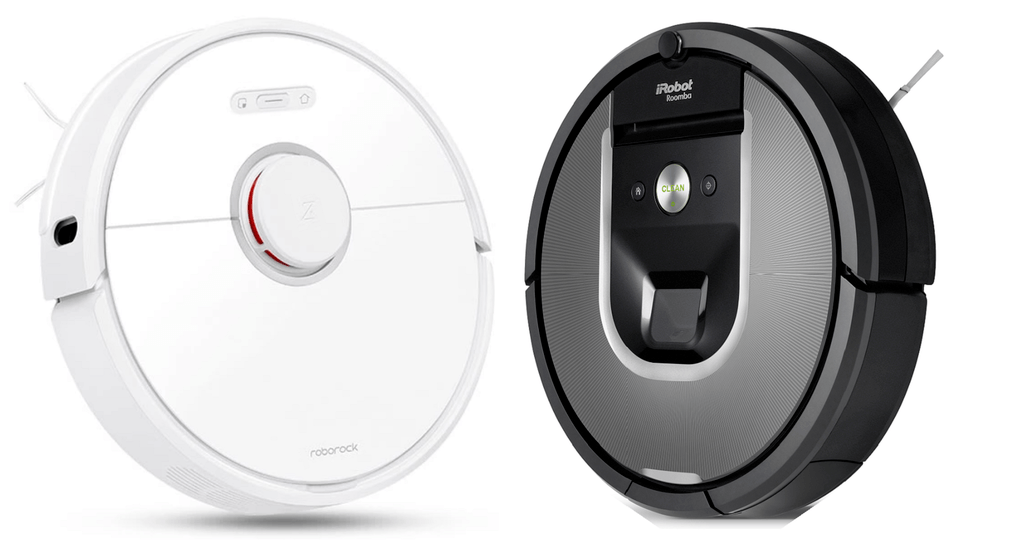Now that Roborock has fundamentally broken away from the Xiaomi network of robot building, they are making a splash and a name for themselves. In the meantime, iRobot continues to raise the bar with technological advancements. While the Roborock S6 doesn’t compete well with the likes of the Roomba i7 , how does it compare to the Roomba 980?
It may be too little, too late for Roborock S6 to compete with the latest models on the market, but older generation robots, like the Roomba 980, might have met their match. The review will compare the two robots to help you determine which model is the best option for you and your home.
Contents
- 1 Differences between Roborock S6 and Roomba 980
- 2 Similarities between Roborock S6 and Roomba 980
- 3 Specification Chart
- 4 Comparing the Roomba 980 to the Roborock S6
- 4.1 Roborock’s Mopping Feature Leaves a Lot To Be Desired
- 4.2 Roborock has the Bigger Battery; Roomba is More Efficient
- 4.3 Roomba and Roborock Have Different Navigation and Mapping Methods
- 4.4 Multiple Control Options Offer You More Freedom
- 4.5 Containment, Extraction Method and Floor Types, all edged by Roomba
- 5 Frequently Asked Questions
- 6 What I Like About the Roborock S6
- 7 What I Like About the Roomba 980
- 8 Conclusion
Differences between Roborock S6 and Roomba 980
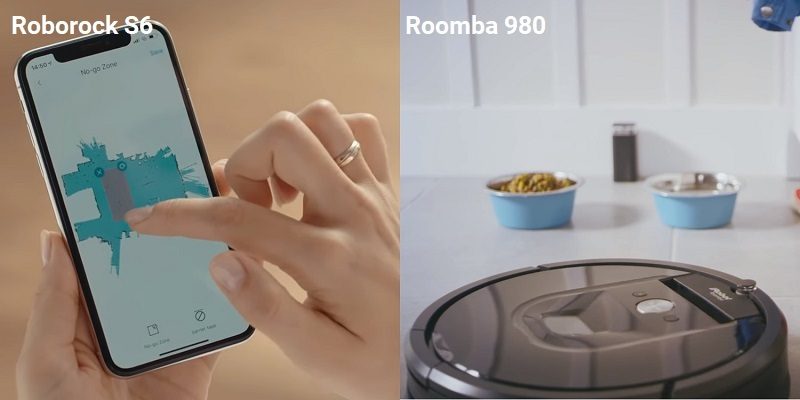
With advancements in robotics being made every day, it is easy to see how just a generation or two can make a huge difference. The Roomba 980 is a formidable robot, but the Roborock S6 has newer technology. Here are where the two differ.
- The biggest difference is that the Roborock S6 is an all-in-one model that sweeps, vacuums, and mops. Roomba vacuums do not mop.
- The Roomba battery has a much smaller capacity but is more efficient than the Roborock battery.
- The filters for both models are HEPA rated, but the Roborock filter is washable while the 980’s filter is not.
- Navigation and mapping. Roomba uses camera-based iAdapt 2.0 navigation and mapping. Roborock S6 uses laser-guided methods.
- Multi-floor mapping. The Roborock S6 can store maps for three different floor plans. Roomba 980 can only store a single floor plan.
- Roomba uses physical containment options with dual-mode virtual wall barriers. Roborock uses digital containment through the mobile app.
Similarities between Roborock S6 and Roomba 980
As you can imagine, through the functionality of these robots, they are going to share some features. Here is what they have in common.
- With only one pound and less than a tenth of an inch height differences, the overall dimensions are quite similar.
- Recharge and Resume. Both models monitor their battery charge and will automatically recharge when needed, then resume cleaning where they left off.
- Wireless communications. The two models use wireless communications for the mobile app and voice command controls.
- Collection bins. The capacity for the collection bins is identical for these two models.
- Side brush. Unlike some other models, the S6 and 980 both use a single side brush for edge and corner cleaning.
Specification Chart
Here, we take a look at all the features and options in a side by side comparison chart to give you a quick-look at what options each model offers.
| Roomba 980 | Roborock S6 | |
| Dimensions | 13.8×13.8×3.6 inches | 13.7×13.8×3.8 inches |
| Weight | 8.7 pounds | 7.7 pounds |
| Battery | 3600mAh lithium-ion | 5200mAh lithium-ion |
| Runtime | Up to 120 minutes | Up to 250 minutes |
| Charge Time | 3 hours | 5 hours |
| Automatic Recharge | Yes | Yes |
| Automatic Resume | Yes | Yes |
| Filter | High-Efficiency | E-11 HEPA, washable |
| Motor Suction | 1900pa | Up to 2000pa |
| Scheduling | Yes | Yes |
| Spot Cleaning | Yes | Yes |
| Real Time Location and Programming | Yes | Yes |
| Wireless Communications | Yes | Yes |
| Local Controls | Yes | Yes |
| Mobile App | Yes | Yes |
| Voice Commands | Yes | Yes |
| Navigation | Camera-Based Navigation | Multi-Sensor Multi-Room |
| Mapping | iAdapt 2.0 | LDS |
| Collection Bin Capacity | 0.5L | 0.5L |
| Water Reservoir Capacity | N/A | 0.15L |
| Noise Level | 67dB | 50dB |
| Adjustable Water Level | N/A | Yes |
| Select Room Navigation | No | Yes |
| Select Room Scheduling | No | Yes |
| Multiple Maps Stored | No | Yes (3 maps) |
| Containment | Yes (physical only) | Yes (app only) |
| Side Brush | 1 | 1 |
| Floor Types | All | All |
| Sensors | 8 | 14 |
| Dry Mop | N/A | No |
| Damp Mop | N/A | Yes |
| Wet Mop | N/A | Yes |
| Warranty | 1 year | 2 years |
| Price | Check on Amazon | Check on Amazon |
Comparing the Roomba 980 to the Roborock S6
Now we get into it. Let’s break these two robots down and compare them, apples to apples, to see how well they perform. By the end of this section, you will have a better idea of which robot is better suited to clean your floors.
Roborock’s Mopping Feature Leaves a Lot To Be Desired
[easyazon_image align=”center” height=”500″ identifier=”B07RLRWWPJ” locale=”US” src=”https://smartrobotichome.com/wp-content/uploads/2020/01/51wa4HYClOL.jpg” tag=”srh-easyazon-20″ width=”500″]Let’s start this comparison with the apparent win for Roborock. The mopping robot uses a water reservoir for a true wet mop. Because of the type of mopping pads, it isn’t able to do what is known as a dry mop. A dry mop is like a duster or a polish. The microfiber mopping pads won’t collect dust and debris.
You can spray or wet the floor if you don’t want to use the water tank, and the robot will wet the pad with the cleaning solution you spray on the floor. This is known as a damp mop since the robot isn’t providing the water. This is an option if you want to use floor cleaners, which should never be put in the reservoir.
Assuming you want to use the wet mop feature, fill the water tank (0.15L capacity) and select the water flow rate (high or low). It is recommended that before you mop, the robot should run in vacuum mode three times. This can be tedious and a lot to deal with. It is better to vacuum or sweep the floor yourself to save time.
Once the robot and your floors are ready, the robot will run around, spraying the mopping pad to keep it wet and dragging it over your floor. It works a lot like a Swiffer Wet, but without the elbow grease and muscle behind it.
All in all, the mopping feature is dismal. It leaves streaks, tracks dirt, and if you aren’t careful will end up on your carpet. I believe Roborock would be better off removing the mopping feature altogether, but they didn’t ask me.
Bottom Line: The Roborock wins this round because Roomba doesn’t mop at all.
Roborock has the Bigger Battery; Roomba is More Efficient
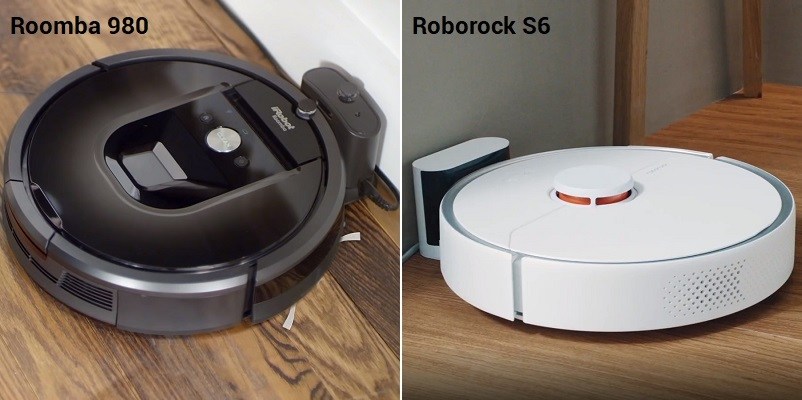
Roborock has always used large celled batteries in all of their machines, and the S6 is no different. Boasting a huge 5200mAh battery pack, the S6 has an estimated runtime of up to 250 minutes.
The Roomba 980, on the other hand, has a modest 3600mAh battery pack that provides up to 120 minutes of power. The actual runtime won’t matter too much, though, as both machines have Recharge and Resume.
The Recharge and Resume feature allows the robots to monitor their own batteries and return to the charging dock when the charge level drops below 15%. After a recharge cycle, the S6 and 980 will both return to the area they left off from and continue cleaning.
The big difference here is that the Roomba 980 will recharge the battery to 100% before returning to work. This can take about 3 hours. The S6, by contrast, will recharge its battery to about 80% and then return to work. The larger battery, though, still takes about three to four hours to get to 80%.
The actual runtimes are misleading as well. The Roborock is a much slower machine, especially when mopping. The Roomba 980 averages about 19 to 21 minutes per room, where the Roborock can stay in a single room for over half an hour. This inefficiency on Roborock’s part, makes the Roomba appear to clean better and faster.
Bottom Line: The Roomba wins this round because it is faster at cleaning and doesn’t waste time or battery power to get around your home.
 When it all boils down, the results are the same. Both robots give you a map of your floor plan through the mobile app. They also store this map internally, so they know where to go, where they have been and where they are in relation to their charging stations.
When it all boils down, the results are the same. Both robots give you a map of your floor plan through the mobile app. They also store this map internally, so they know where to go, where they have been and where they are in relation to their charging stations.
How thy go about this is a bit different. Roomba uses iAdapt 2.0 technology. This is a fancy iRobot name for their navigation system. It is a camera-based system that takes hundreds of images as it moves around your home.
The images are then put together to form a 3-D map of your home. Using this map, the 980 knows where your couches are, the walls and doorways, and can maneuver accordingly. If you make changes (say you move your furniture around), the robot will update the map with new photos as it cleans.
The Roborock S6 used laser-guided navigation. Instead of camera images, the S6 has a laser that scans the room, or more specifically, the ceiling. It notes where the walls come together, and uses lights, ceiling fans, etc. as landmarks.
As the robot moves around, it will bump into the walls, furniture, and other obstacles to complete the map-making process. Using these bump readings, the robot knows where your furniture is in relation to the landmarks from the ceiling scans. This is the same navigation method used by Neato if you are familiar.
To be honest, one isn’t better than the other. However, Roborock stands out over the 980 because it can scan and store three different floor plans. The Roomba robot can scan and save one floor plan. If moved to a new location, the original scan is erased.
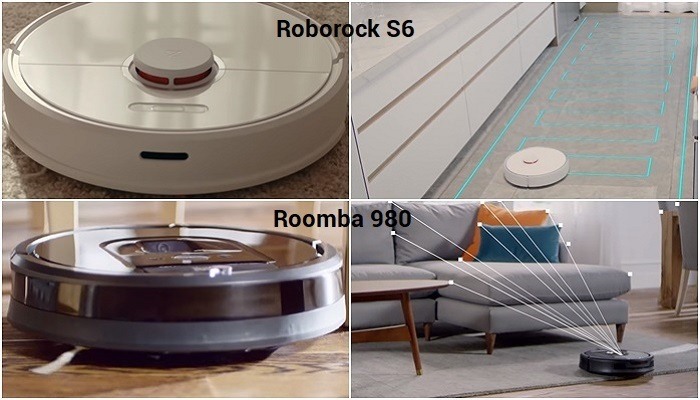
Bottom Line: This is a tie since the systems have the same results. Though the Roborock gets a bonus point for storing more maps at once.
Multiple Control Options Offer You More Freedom
The Roomba 980 and Roborock S6 both give you multiple control options. The first of which are local controls. These are physical buttons located on the robot themselves. You can press them to accomplish various tasks.
In the case of the Roomba, you can start (or pause) a cleaning cycle, perform a spot clean or send the robot back to the charging station. You won’t be able to do anything else with the local controls, but you won’t want to.
The S6 has similar functionality with the local controls, and like the Roomba, they might be the least used control option you have. Both models push the use of their mobile app for complete control over the robot at all times.
Mobile Apps are Crucial
Through the iRobot Home app, you can create schedules, view the created map, and get status reports on the battery charge and filters. You will be able to set the date and time and give the Roomba a nickname, too.
Through the app, you can pick the cleaning mode, start a non-scheduled cleaning session o end one prematurely if needed. Even if you aren’t home, the app will communicate with the robot and get the task completed.
Roborock’s app is a bit more confusing. First, it is because there are currently two apps in the market place. The first is the Xiaomi app, which is also used to control previous versions of the Roborock robots, Xiaomi’s lights, and other smart home devices.
Roborock broke free of this and developed an app just for their robots. The Xiaomi app doesn’t sync with the S6, so you will need to make sure you get the correct app (Andorid or iOS). Once you do, the process is a little simpler than it has been in years past. The interface is cleaner, and controls are simpler.
You will be able to control the robot in all the same methods as the Roomba, including creating schedules and viewing the map. What you can’t do with the Roomba 980, though, is to use digital containment, or schedule individual rooms.
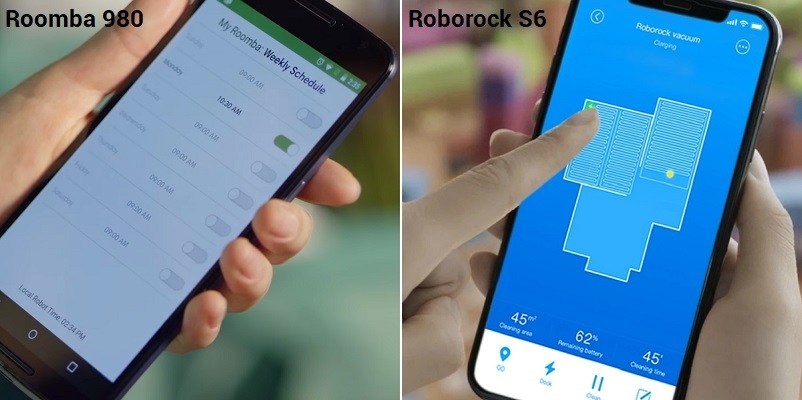
The S6 allows you to do this. You can name your rooms and then schedule them to be cleaned at different times. For example, you can make the S6 clean the living room at noon and the bedrooms at 5 pm. Select Room scheduling is a feature found in Roomba’s i7 and s9 robots, but the 980 isn’t capable.
Voice Commands go to Roomba
Both the S6 and 980 are compatible with Google Assistant and Amazon Alexa. You can use voice commands to control your robot when you are at home.
The Roborock commands are quite limited. With Alexa, you have two commands, “on” and “off.” Google adds a third command “home” because “off” pauses the cleaning session where it stops and sends the robot to the charging station with Alexa.
The 980, on the other hand, has many voice commands. You can use your voice to start, stop, pause, resume, cancel, or create scheduled cleanings. You can even get status reports, check on robot location, and edit schedules. While the app gives you more control, there is a lot you can do with your voice.
Bottom Line: Roomba 980 gets the edge here. With a better mobile app, more voice commands, and local controls that simply work, it’s a step up from the Roborock version, even with their select room scheduling.
Containment, Extraction Method and Floor Types, all edged by Roomba
I mentioned above about Roborock’s digital containment. Allow me to go into more detail here. The S6 uses No-Go lines, also similar to Neato’s digital containment option. Like Neato (when the feature was first released), it doesn’t work so well.
The idea is that you interact with the map and draw lines that you don’t want the robot to cross. The app then sends the updates to the map to the robot, who then treats the lines like physical walls. In theory, it is a simple and economical means of containment.
In reality, it hardly works. The robot usually ignores the lines, or it is added to the internal map in the wrong area. For example, when you draw a line between your kitchen and living room so the robot can mop for you, you may find that the robot makes a direct line for the carpeted side and doesn’t cross over to the hard flooring.
To be fair, though, Roborock is aware of the problems and has updated the app several times in the previous months to help correct it. The problems are getting less frequent, and the feature is more robust, but it still has issues.
The Roomba 980 uses physical containment. The dual-mode virtual wall barriers, create barriers of infrared light that the 980 picks up on and avoids like it was a real wall. There have been a handful of complaints about this in the six years the barriers have been available. Each time it came down to user-error.
Floor Types Ratings are Misleading
With the Roomba 980, you will find that you can clean any floor type. This includes all manner of hard flooring such as hardwood, softwood, vinyl, laminate, tile, etc. When it comes to carpeting, you can clean loose or tight woven carpeting in low, medium, or high pile. Some shag carpeting will cause issues, but for the most part, the 980 can clean them all.
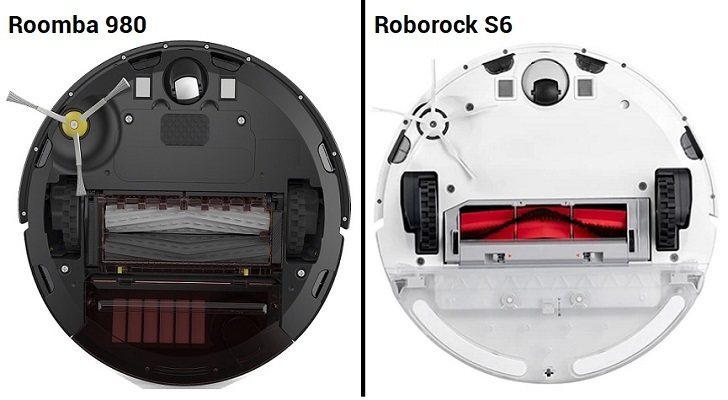
This is due to the extraction method the 980 uses. Dual, counter-rotating brushless rollers are tangle-free and easy to maintain. They also don’t have the bristles that can scratch softer surfaces and get caught on carpet fibers.
In the event the robot does run over a power cord, a sock, or something else to get caught, it will reverse the rotation of the rollers in an attempt to free itself. If successful, the robot continues cleaning. If it fails, the 980 will shut down to prevent damage and alert you through a series of beeps.
Roborock has a bristle brush roller that doesn’t handle high pile or loosely woven carpets at all. Low pile carpets are fine, and you can clean most hard surfaces as well. However, if you have a softer surface like pine or a sealed surface, you may find that the bristles leave tiny scratches. You will want to test in a small area before you let the robot loose.
Bottom Line: The Roomba 980 wins. There isn’t a floor type it can’t clean, and the containment options are more reliable.
Frequently Asked Questions
Now, I will answer some of the more common questions about these two robots and their manufacturers. If you have other questions, please use the comment section below.
Q. What type of filter do these robots use?
A. The Roomba 980 uses a high-efficiency, disposable filter. It is HEPA rated for reducing in-home allergens. Each filter will last between 4 and 6 months. The Roborock S6 uses an E-11 HEPA filter that is washable. You can get up to 9 months’ use from each filter before it begins to wear from washing.
Q. How do I contact iRobot for assistance?
A. You can call iRobot customer service directly at 1-800-727-9077. If you prefer email contact or live chat options, you can find the corresponding addresses (based on your location and department to contact) as well as chat links on their customer service page.
Q. How do I contact Roborock for assistance?
A. Roborock currently only has email contact options. You can send an email to support@roborock.com for further assistance.
Q. How loud is the Roomba 980 compared to the Roborock S6?
A. The 980 is quite loud when compared to the 50dB noise level of the S6. Roomba comes in at about 65 to 667dB, which is about the same as a hairdryer. You will notice when the 980 is in the room.
What I Like About the Roborock S6
- Is an all-in-one robot that sweeps, vacuums and mops.
- HEPA filter is washable, saving you money in the long run.
- Digital containment option for easier control.
What I Like About the Roomba 980
- Best mobile app on the market for user-friendly interface and functionality.
- Efficient use of battery and power.
- Brushless rollers work on all floor types without tangles.
- 5-minute maintenance routine keeps the robot going strong.
Conclusion
There is no question that the Roborock S6 is a fine robot vacuum. It may not be the best mopping option out there, but it does have the ability. The Roomba 980 is also a high-quality robot vacuum. So which one do you choose?
If you want more technology and a robot that is still being updated, the Roborock S6 is your answer. It has everything you need and will clean your hard flooring as well as low and medium pile carpeting reasonably well.
The Roomba 980, though, is a few generations old. It compares well to the S6 in cleaning ability and ease of use, but it has better reviews, more options, and a better user-friendly mobile app. In the end, it is a tough call, but for reliability, durability, and functionality, the Roomba 980 is a better choice.
